Attached files
| file | filename |
|---|---|
| 8-K - 8-K - REGIONS FINANCIAL CORP | d407158d8k.htm |
 BARCLAYS GLOBAL
FINANCIAL SERVICES
CONFERENCE
September 11, 2012
David Turner
Chief Financial Officer
Exhibit 99.1 |
 2
INVESTMENT THESIS
Attractive
Market Presence
•
Leading Southeastern depository franchise with favorable demographics
•
Leading brand favorability
•
Top share in core markets
Improved Credit Profile
•
Aggressive risk management initiatives
•
Significant reduction in higher risk loan portfolios
•
Significant improvement in credit quality metrics
Comprehensive
Product Offering
•
Balanced business mix
•
Momentum in C&I and consumer offerings
•
Focused on core banking business post sale of Morgan Keegan
•
Sustainable and improving core profitability
•
Opportunity for outperformance
•
Significant credit leverage remaining
Strong Funding Profile
and Capital Position
•
Continued growth in low cost core deposit base
•
Loan to deposit ratio well below historical and peer levels
•
Attractive liquidity position and funding profile
•
Capital levels are solid
Profitability |
 3
FRANCHISE OVERVIEW
•
Bank Associates: 23,422
•
Assets: $122B
•
Loans: $76B
•
Deposits: $95B
•
Branches: 1,719
•
Insurance Offices: 30
•
ATMs: 2,063
•
Market Cap: $10.1B*
*As of August 27, 2012
Business Services
›
Small and mid-sized C&I lending
›
Commercial Real Estate
›
Equipment Finance
Consumer Services
›
Mortgage
›
Home Equity
›
Credit Card
›
Direct Lending
›
Indirect Auto
Wealth Management
›
Institutional Services
›
Private Wealth Management
›
Investment Services
›
Insurance
Ranked 4th or Better in Market Share
Targeted Growth Areas |
 4
DOING THE RIGHT THING
We believe being a responsible bank means being an integral part
of our communities.
Community Service
Housing Assistance
Disaster Response
Policy
›
Regions associates
volunteered for nearly 5,300
community service activities
in first-half 2012
›
Included teaching 3,300-plus
financial education classes
›
Impacted students at all
levels, potential first-time
homebuyers, small business
owners
›
Significant increase over
previous years due to
company-wide emphasis on
service
›
Regions Customer
Assistance Program (CAP)
has helped more than
45,000 homeowners
restructure $3.9 billion in
mortgages, keeping people
in their homes after job loss,
natural disasters and other
setbacks
›
Regions foreclosure rate
remains well below industry
average
›
Regions promotes affordable
housing by investing in Low
Income Housing Tax Credits
›
Assistance can include:
›
Penalty free withdrawals
on CDs
›
Personal and business
loan deferral
›
Up to 3 months payment
forbearance/extensions for
all Consumer Loan/Line
Products
›
ATM fees waived
›
NSF/OD Fees waived
›
Mobile ATM available for
deployment |
 5
REGIONS’
FOOTPRINT IS CHARACTERIZED BY EITHER HIGH
MARKET SHARE, HIGH GROWTH MARKETS OR BOTH
Source: SNL Financial
Note: Core Markets include AL, FL, LA, MS, AR, TN
Weighted Average Deposit Market
Share in Regions’
Core Markets
Rank
Name
Market
Share
1
Bank of America
11.5%
2
Regions
9.8%
3
Wells Fargo
9.4%
4
SunTrust
6.9%
5
JPMorgan Chase
3.3%
6
BB&T
2.5%
7
Capital One
2.3%
8
First Horizon
2.0%
9
Hancock
1.9%
10
PNC
1.4% |
 6
CONTINUED MOMENTUM IN ASSET QUALITY METRICS
*Year-over-year change
**Excludes loans held for sale |
 7
SIGNIFICANT REDUCTION IN HIGH RISK LOAN
PORTFOLIOS
Total Investor Real Estate
Investor Real Estate as % of Total Loans
Reduced Investor Real Estate
$16.4 B or 64% since 4Q06
Investor Real Estate as a % of total loans
has decreased since 4Q06
4Q06
2Q12 |
 8
RENEWED FOCUS ON C&I AND CONSUMER LENDING
BUSINESS SERVICES
•
61% of Total Loan Portfolio
•
Focused on middle market and small business
•
Broad based middle-market commercial loan growth across
footprint and industries
•
Driven by specialized industries, including healthcare,
franchise restaurant, energy, transportation, as well as
technology and defense
CONSUMER SERVICES
•
39% of Total Loan Portfolio
•
Consumer loan growth will be fueled by new businesses as
well as growth in existing businesses
•
Mortgage loan production totaled $2.1 billion in 2Q
•
Non-real estate consumer portfolio has increased 3% YoY
•
$1B Regions-branded credit card portfolio now serviced in-
house
•
Indirect auto lending grew 21% YoY
2Q12 Business Services Loans: $46B
2Q12 Consumer Services Loans: $30B
* Includes commercial real estate owner occupied loans
|
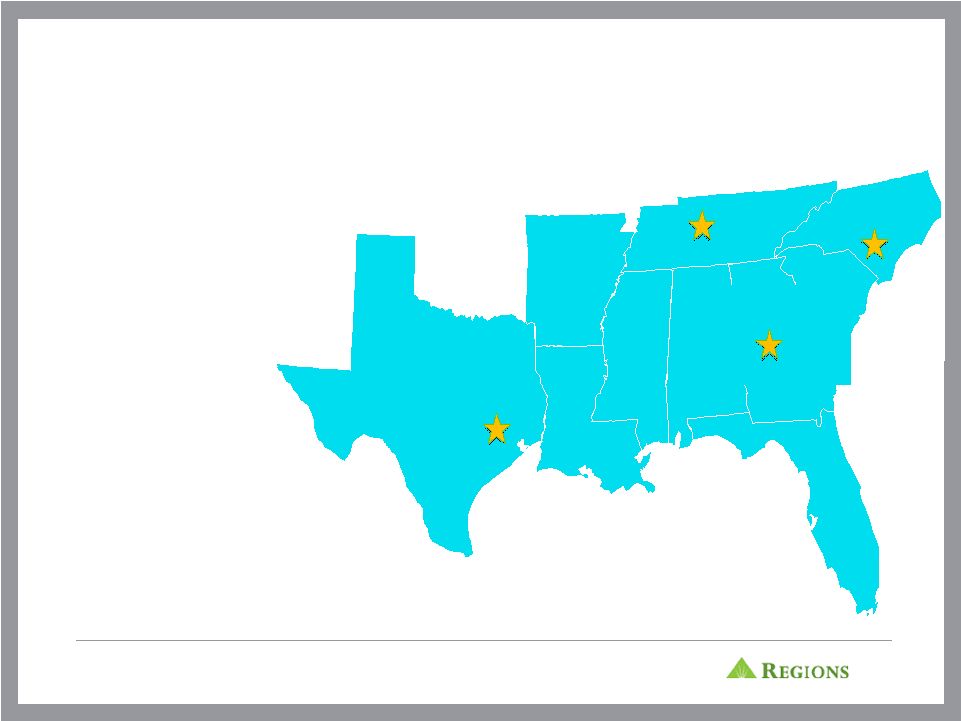 9
•
Specialized lending groups are
headquartered throughout our
footprint
•
Our goal is to be the premier
corporate middle market bank
for the specialized
industries we serve
•
Experienced positive year over
year growth in all industries
BUSINESS SERVICES FOCUSED ON SPECIALIZED
INDUSTRIES
Transportation
Restaurant
Healthcare
Technology/Defense
Energy
(Houston)
(Atlanta)
(Charlotte)
(Nashville) |
 10
LOAN COMMITMENTS AND UTILIZATION INCREASE
Commitments and Outstandings
•
Commercial & industrial line utilization rose 130 basis points linked quarter
to 44.4% •
Commitments increased $3.2 billion since last year to $31.2 billion
•
Commercial & industrial loan balances on an average basis increased $902
million, or 4% linked quarter reflecting strength in our middle market
portfolio |
 11
2Q12 FINANCIAL HIGHLIGHTS
Adjusted Pre-tax Pre-provision Income from Continuing
Operations
(1)
Loan Loss
Provision
$398
$355
$295
$117
$26
(1)
Non-GAAP -
See GAAP to non-GAAP reconciliation in appendix, excludes goodwill only
(2)
Annualized
With each passing quarter, we are better positioned for ultimate
outperformance.
2Q12 Financial Results
Net Income
$284MM
Income from continuing
operations
$351MM
EPS
$0.20
Impact of Series A
Preferred Stock
(1)
$0.05 |
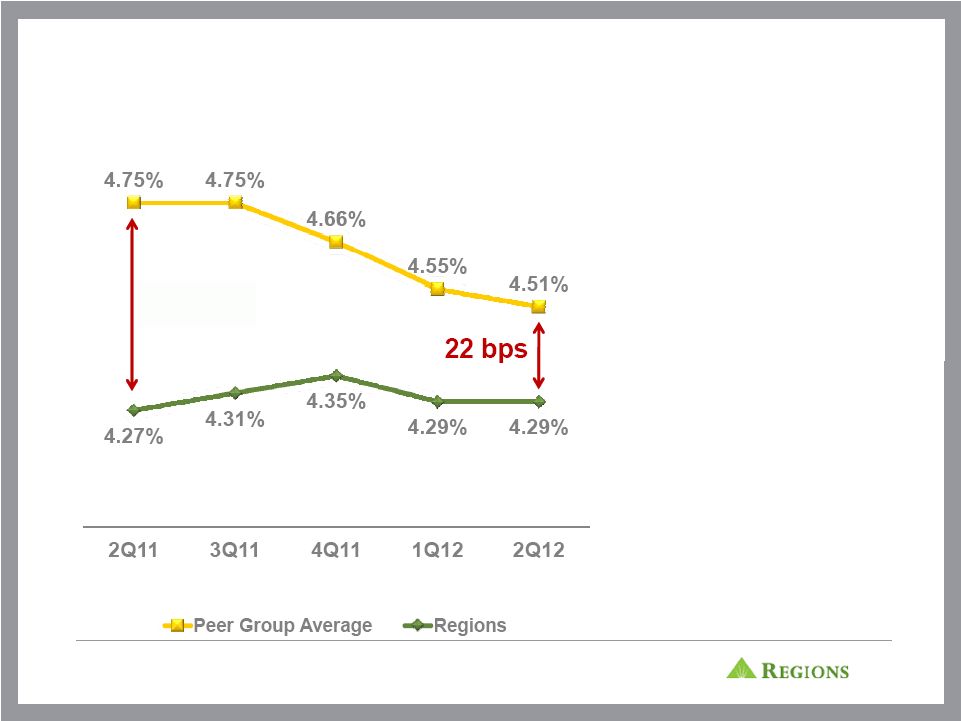 12
CLOSING THE GAP ON LOAN YIELDS
•
Commercial & industrial loan
balances on an average basis
increased 4% linked quarter
reflecting strength in our middle
market portfolio
•
Commercial & industrial line
utilization rose 130 basis points
to 44.4%
•
Loan yield remained flat linked
quarter despite the low rate
environment
Note: Peer banks include BBT, CMA, FHN, FITB, HBAN, KEY, MTB, PNC, STI, USB,
WFC, ZION 48 bps |
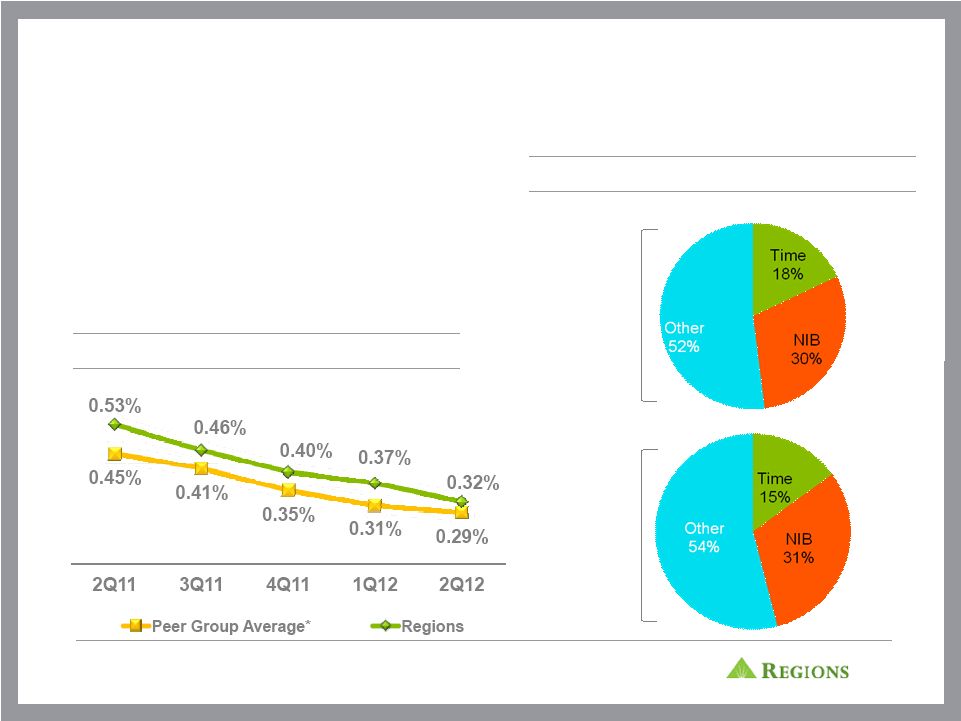 13
MIX AND COST OF DEPOSITS PROVIDE FURTHER
OPPORTUNITY TO LOWER DEPOSIT COSTS AND IMPROVE
MARGIN
Deposit Mix Compared to Peers*
Regions
Peer
Average
*Average basis for 2Q12
Source: SNL Financial: Peer banks include BBT, CMA, FHN,
FITB, HBAN, KEY, MTB, PNC, STI, USB, WFC, ZION •
Deposit repricing opportunities remain, maturities
include:
•
3Q12 -
$2.9B at 1.2%
•
4Q12 -
$3.0B at 2.1%
•
1H13 -
$4.6B at 1.8%
•
2H13 -
$1.9B at 0.8%
Deposit Cost Opportunity Gap |
 14
FUNDING MIX AND DEPLOYMENT OF CASH RESERVES
HAVE AIDED NET INTEREST MARGIN AND CLOSING THE
GAP TO PEERS
Impact of Excess Cash Reserves & Non-
Accruals on NIM*
Regions has closed a portion of its gap vs.
peers in the last 5 quarters
* From continuing operations
Source: SNL Financial: Peer banks include BBT, CMA, FHN, FITB, HBAN, KEY, MTB, PNC,
STI, USB, WFC, ZION |
 15
MORTGAGE INCOME INCREASED 17% LINKED QUARTER
•
Non-interest
(1)
revenue decreased 3%
linked quarter
•
Mortgage revenues increased 17%
linked quarter and 80% over last year
•
HARP II expected to increase
mortgage volume by $1 billion in
2012
•
Service charges declined linked quarter
due to the establishment of a reserve for
certain customer fee refunds resulting
from a change in the company’s non-
sufficient funds policy
Fee Income by Quarter
(1)
From continuing operations adjusted to exclude security gains and leveraged lease
terminations gains–Non-GAAP, see appendix for GAAP to Non-GAAP
reconciliation 1 |
 16
OUTPACED PEERS IN EXPENSE REDUCTION IN 2Q12
•Adjusted to exclude non-core items
Source: SNL Financial: Peer banks include BBT, CMA, FITB, HBAN, KEY, MTB, PNC, STI,
USB, WFC, ZION Change in Non-Interest Expense* 2Q12 vs 1Q12
|
 17
REGIONS HAS THE LOWEST EXPENSE TO ASSETS RATIO
* Adjusted to exclude non-core items, ratios are annualized
Source: SNL Financial: Peer banks include BBT, CMA, FHN, FITB, HBAN, KEY, MTB, PNC,
STI, USB, WFC, ZION Non-Interest Expense* / Average Assets
|
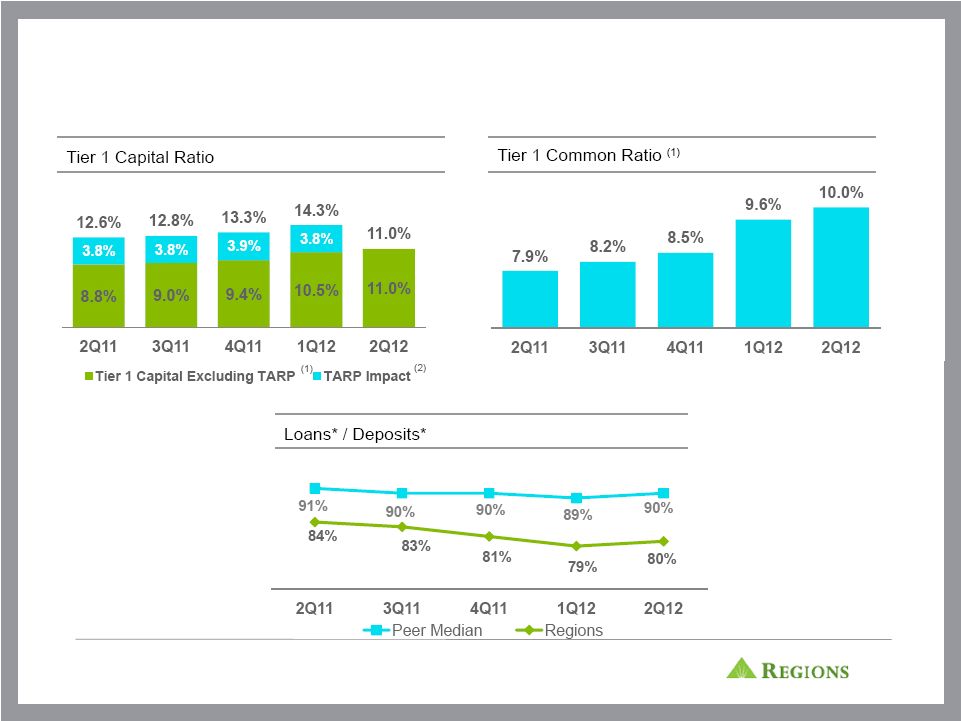 18
STRONG FUNDING PROFILE AND LIQUIDITY POSITION
Source: SNL Financial -
Peers include BBT, CMA, FHN, FITB, HBAN, KEY, MTB, PNC, STI, USB, WFC,
ZION *Based on ending balances
(1)
Non-GAAP –
See appendix for reconciliation
(2)
Includes Series A Preferred Stock and associated warrant
|
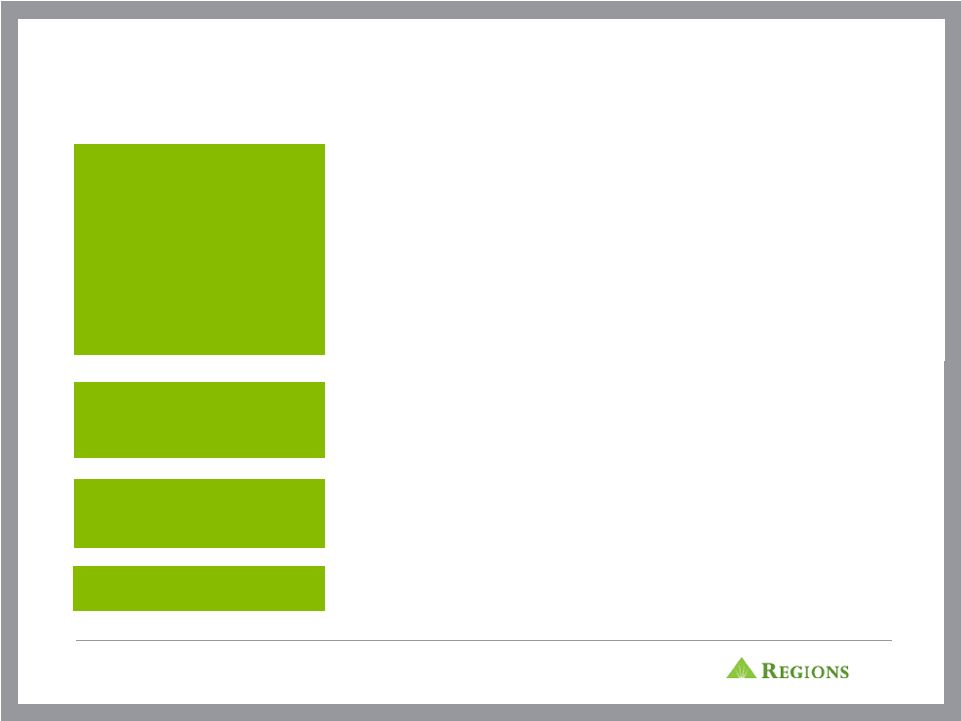 19
OPPORTUNITY FOR OUTPERFORMANCE
REVENUE
EXPENSES
CREDIT
•
Tangible opportunity to close peer margin gap
•
Over $12.4 billion of deposit repricing through 2H13
•
Lower liquidity costs
•
Reduction of non-accruals
•
Continued momentum in C&I and Consumer lending
•
Development of new products and services
•
Ongoing expense initiatives
•
Anticipating reduced credit related / OREO expenses
•
Solid reserve position
•
Reduced provisions with continued credit improvement
•
Positioned for increased future capital return
CAPITAL |
 20
APPENDIX |
 21
FORWARD-LOOKING STATEMENTS
›Regions’
ability to receive dividends from its subsidiaries.
›The effects of the failure of any component of Regions’
business infrastructure which is provided by a third party.
›Changes in accounting policies or procedures as may be required by the
Financial Accounting Standards Board or other regulatory agencies.
>The effects of any damage to Regions reputation resulting from
developments related to any of the items identified above ›The
foregoing list of factors is not exhaustive. For discussion of these and other factors that may cause actual results to differ from expectations, look under the captions “Forward-Looking Statements”
and “Risk
Factors”
in Regions’
Annual Report on Form 10-K for the year ended December 31, 2011 and the
"Foward-Looking Statements" section of Regions' Quarterly Reports on Form 10-Q for the quarters ended March 31, and June
30, 2012.
›The words "believe," "expect," "anticipate,"
"project," and similar expressions often signify forward-looking statements. You should not place undue reliance on any forward-looking statements, which speak only as of the
date made. We assume no obligation to update or revise any
forward-looking statements that are made from time to time.
›Possible changes in consumer and business spending and saving habits
could affect Regions' ability to increase assets and to attract deposits.
›The effects of weather and natural disasters such as floods, droughts,
wind, tornados and hurricanes, and the effects of man-made disasters.
›Possible downgrades in ratings issued by rating agencies.
›Possible changes in the speed of loan prepayments by
Regions’ customers and loan origination or sales volumes.
›Possible acceleration of prepayments on mortgage-backed securities
due to low interest rates and the related acceleration of premium amortization on those securities.
›The effects of problems encountered by larger or similar financial
institutions that adversely affect Regions or the banking industry generally.
›Regions' ability to keep pace with technological changes.
›Regions' ability to effectively manage credit risk, interest rate
risk, market risk, operational risk, legal risk, liquidity risk, reputational risk, and regulatory and compliance risk.
›Regions’
ability to ensure adequate capitalization which is impacted by inherent
uncertainties in forecasting credit losses. ›The cost and other
effects of material contingencies, including litigation contingencies, and any adverse judicial, administrative or arbitral rulings or proceedings.
›The effects of increased competition from both banks and
non-banks. ›The effects of geopolitical instability and risks
such as terrorist attacks. ›Possible changes in trade, monetary
and fiscal policies, laws and regulations and other activities of governments, agencies, and
similar organizations, may have an adverse effect on business.
>Possible regulations issued by the Consumer Financial Protection Bureau
or other regulators which might adversely impact Regions' business model or products and services.
›Possible stresses in the financial and real estate markets, including
possible continued deterioration in property values. ›Regions'
ability to manage fluctuations in the value of assets and liabilities and off-balance sheet exposure so as to maintain sufficient capital and liquidity to support Regions' business.
›Regions' ability to expand into new markets and to maintain profit
margins in the face of competitive pressures. ›Regions' ability
to develop competitive new products and services in a timely manner and the acceptance of such products and services by Regions' customers and potential customers.
›The Dodd-Frank Wall Street Reform and Consumer Protection Act (the
“Dodd-Frank Act”)became law in July 2010, and a number of legislative, regulatory and tax proposals remain pending. Additionally, the U.S. Treasury
Department and federal banking regulators continue to implement,
but are also beginning to wind down, a number of programs to address
capital and liquidity in the banking system. Future and proposed rules, including those
that are part of the Basel III process, are expected to require banking
institutions to increase levels of capital. All of the foregoing may have significant effects on Regions and the financial services industry, the exact nature
and extent of which cannot be determined at this time.
›Possible additional loan losses, impairment of goodwill and other
intangibles, and adjustment of valuation allowances on deferred tax assets and the impact on earnings and capital.
›Possible changes in interest rates may increase funding costs and
reduce earning asset yields, thus reducing margins. Increases in benchmark interest rates would also increase debt service requirements for customers
whose terms include a variable interest rate, which may negatively impact
the ability of borrowers to pay as contractually obligated.
›Possible changes in general economic and business conditions in the
United States in general and in the communities Regions serves in particular, including any prolonging or worsening of the current unfavorable
economic conditions including unemployment levels.
›Possible changes in the creditworthiness of customers and the possible
impairment of the collectability of loans. |
 NON-GAAP RECONCILIATION: NET INCOME / (LOSS) AND
EARNINGS PER SHARE
`
(1) |
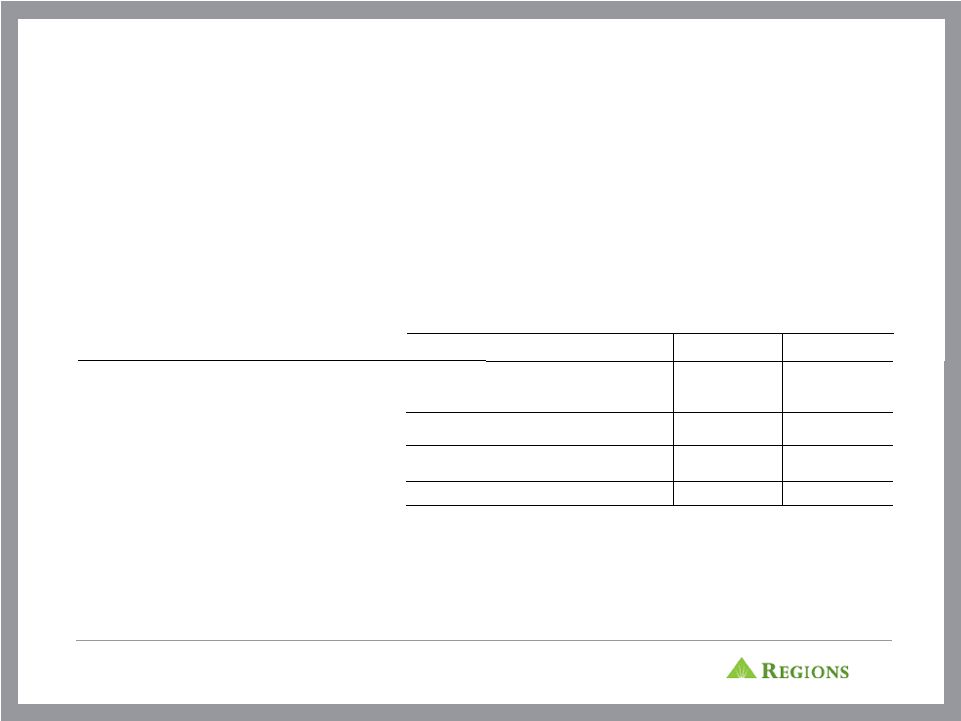 23
NON-GAAP RECONCILIATION: PRE-TAX PRE-PROVISION
INCOME
The Pre-Tax Pre-Provision Income from Continuing Operations table below presents computations
of pre-tax pre-provision income from continuing operations excluding certain
adjustments (non-GAAP). Regions believes that the exclusion of these adjustments provides a
meaningful base for period-to-period comparisons, which management believes will assist
investors in analyzing the operating results of the Company and predicting future
performance. These non-GAAP financial measures are also used by management to assess the performance
of Regions' business. It is possible that the activities related to the adjustments may recur;
however, management does not consider the activities related to the adjustments to be
indications of ongoing operations. Regions believes that presentation of these non-GAAP financial
measures will permit investors to assess the performance of the Company on the same basis as that
applied by management. Non-GAAP financial measures have inherent limitations, are
not required to be uniformly applied and are not audited. Although these non-GAAP financial
measures are frequently used by stakeholders in the evaluation of a company, they have limitations as
analytical tools, and should not be considered in isolation, or as a substitute for analyses
of results as reported under GAAP. In particular, a measure of income that excludes
certain adjustments does not represent the amount that effectively accrues directly to
stockholders. (1)
After
tax
amounts
for
leveraged
lease
terminations
gains
are
$0.6
million
for
6/30/2012,
$3.1
million
for
3/31/2012,
$2.8
million
for
12/31/11
and $5.4 million for 9/30/11.
($ amounts in millions)
6/30/12
3/31/12
12/31/11
9/30/11
6/30/11
common shareholders (GAAP)
280
$
185
$
(135)
$
87
$
25
$
95
$
51.4%
255
$
NM
71
54
54
54
54
17
31.5%
17
31.5%
126
82
18
17
(34)
44
53.7%
160
NM
taxes (GAAP)
477
321
(63)
158
45
156
48.6%
432
NM
26
117
295
355
398
(91)
-77.8%
(372)
-93.5%
(non-GAAP)
503
438
232
513
443
65
14.8%
60
13.5%
-
-
253
-
-
-
-
-
-
excluding goodwill impairment (non-GAAP)
503
438
485
513
443
65
14.8%
60
13.5%
Income (loss) from continuing operations before income
Provision for loan losses (GAAP)
Pre-tax pre-provision income from continuing operations
Pre-tax pre-provision income from continuing operations,
Goodwill impairment
Quarter Ended
2Q12
vs. 1Q12
2Q12
vs. 2Q11
Income (loss) from continuing operations available to
Preferred dividends (GAAP)
Income tax expense (benefit) (GAAP) |
 24
NON-GAAP RECONCILIATION: FEE INCOME RATIOS AND
EFFICIENCY RATIOS
($ amounts in millions)
6/30/12
3/31/12
12/31/11
9/30/11
6/30/11
Continuing Operations
Non-interest expense (GAAP)
842
$
913
$
1,124
$
850
$
956
$
Adjustments:
Securities impairment, net
(2)
-
(2)
-
-
Branch consolidation and property and equipment charges
-
-
2
-
(77)
Goodwill impairment
-
-
(253)
-
-
Adjusted non-interest expense (non-GAAP)
G
840
$
913
$
871
$
850
$
879
$
Net interest income, taxable-equivalent basis (GAAP)
850
$
839
$
858
$
859
$
864
$
Non-interest income (GAAP)
507
$
524
$
507
$
513
$
543
$
Adjustments:
Securities (gains) losses, net
(12)
(12)
(7)
1
(24)
Leveraged lease termination (gains) losses, net
(7)
(7)
(10)
2
-
Adjusted non-interest income (non-GAAP)
H
488
505
490
516
519
Adjusted total revenue (non-GAAP)
I
1,338
$
1,344
$
1,348
$
1,375
$
1,383
$
Fee income ratio (non-GAAP)
H/I
36.5%
37.6%
36.4%
37.5%
37.5%
Efficiency ratio (non-GAAP)
G/I
62.8%
67.9%
64.6%
61.8%
63.6%
As of and for Quarter Ended |
 25
NON-GAAP RECONCILIATION: TIER 1 COMMON
($ amounts in millions, except per share data)
6/30/12
3/31/12
12/31/11
9/30/11
6/30/11
TIER 1 COMMON RISK-BASED RATIO CONSOLIDATED
-
Stockholders' equity (GAAP)
14,455
$
17,534
$
16,499
$
17,263
$
16,888
$
Accumulated other comprehensive (income) loss
(54)
60
69
(92)
177
Non-qualifying goodwill and intangibles
(4,852)
(4,881)
(4,900)
(5,649)
(5,668)
Disallowed deferred tax assets
(336)
(345)
(432)
(506)
(498)
Disallowed servicing assets
(33)
(36)
(35)
(35)
(35)
Qualifying non-controlling interests
92
92
92
92
92
Qualifying trust preferred securities
846
846
846
846
846
Tier 1 capital (regulatory)
10,118
$
13,270
$
12,139
$
11,919
$
11,802
$
Qualifying non-controlling interests
(92)
(92)
(92)
(92)
(92)
Qualifying trust preferred securities
(846)
(846)
(846)
(846)
(846)
Preferred stock
-
(3,429)
(3,419)
(3,409)
(3,399)
Tier 1 common equity (non-GAAP)
O
9,180
$
8,903
$
7,782
$
7,572
$
7,465
$
Risk-weighted assets (regulatory)
P
91,769
92,546
91,449
92,786
93,865
Tier 1 common risk-based ratio (non-GAAP)
O/P
10.0%
9.6%
8.5%
8.2%
7.9%
As of and for Quarter Ended |
 26
NON-GAAP RECONCILIATION: TIER 1 CAPITAL
Regions' Series A preferred stock was repurchased on April 4, 2012 and the warrant
to purchase 48.3 million shares of Regions common stock was retired on May
2, 2012. The following table presents the calculations of Tier 1 capital and the Tier 1 capital ratio,
adjusted as if
the repurchase of the shares and the retirement of the warrant occurred on the last
day of the quarter for each prior period presented. The amount retired
includes the Series A preferred stock plus the remaining balance of the related discount.
($ amounts in millions)
6/30/12
3/31/12
12/31/11
9/30/11
6/30/11
TIER 1 RISK-BASED RATIO
Stockholders' equity
14,455
$
17,534
$
16,499
$
17,263
$
16,888
$
Accumulated other comprehensive (income) loss
(54)
60
69
(92)
177
Non-qualifying goodwill and intangibles
(4,852)
(4,881)
(4,900)
(5,649)
(5,668)
Disallowed deferred tax assets
(336)
(345)
(432)
(506)
(498)
Disallowed servicing assets
(33)
(36)
(35)
(35)
(35)
Qualifying non-controlling interests
92
92
92
92
92
Qualifying trust preferred securities
846
846
846
846
846
Tier 1 capital as reported
10,118
$
13,270
$
12,139
$
11,919
$
11,802
$
Series A Preferred Stock Retirement (Reduction to Stockholders' equity)
-
$
(3,500)
$
(3,500)
$
(3,500)
$
(3,500)
$
Retirement of warrant to purchase 48.3 million shares of Regions
common stock
-
(45)
(45)
(45)
(45)
Tier 1 capital as adjusted to exclude Series A Preferred Stock
10,118
$
9,725
$
8,594
$
8,374
$
8,257
$
Risk-weighted assets
1
91,769
92,546
91,449
92,786
93,865
Tier 1 capital ratio
11.0%
14.3%
13.3%
12.8%
12.6%
Tier 1 capital ratio excluding Series A Preferred Stock and associated
warrant 11.0%
10.5%
9.4%
9.0%
8.8%
Quarter Ended |
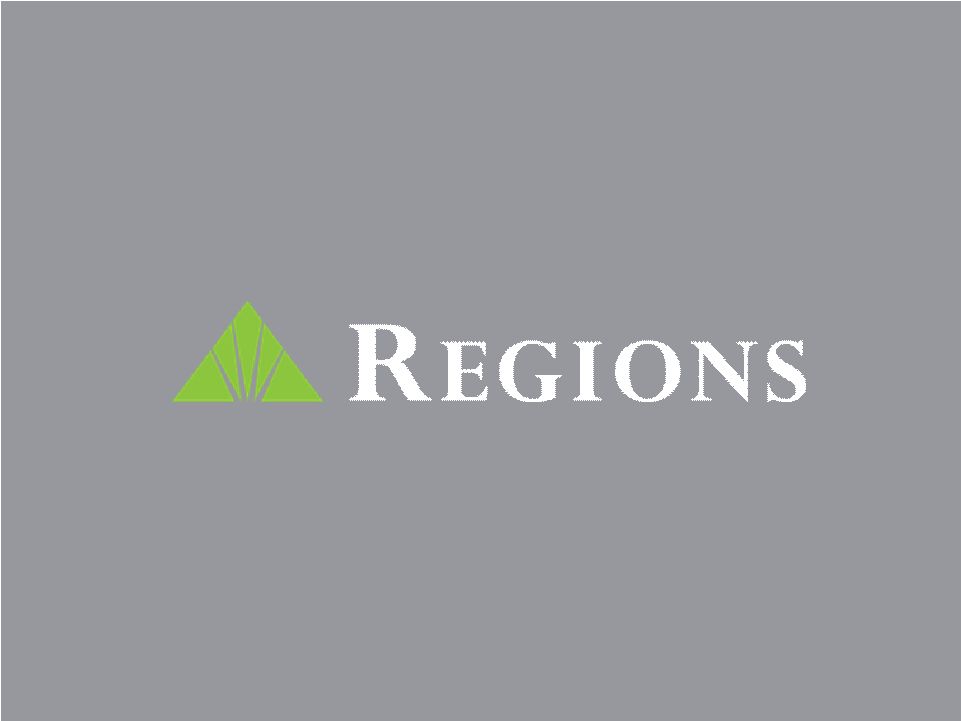 |
